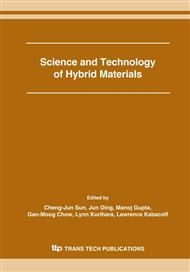p.39
p.43
p.47
p.51
p.55
p.59
p.63
p.67
p.71
Phase Transition and Thermochromism of the Hybrid (C12H25NH3)2FeCl4
Abstract:
This paper focuses on the structural change and the thermochromism of the phase transition of the hybrid (C12H25NH3)2FeCl4. The temperature and the structures of the phase transition is investigated by a thermal gravimetry (TG) and differential scanning calorimetry (DSC), an infrared spectra (IR) and X-ray diffraction (XRD) patterns. The UV adsorption spectra account for the thermochromism. The results suggest that the reversible phase transition arises from the structural changes of the organic chains. The thermochromism is presumably due to the electrons redistribution on the levels and to the energy transition to translational and rotational motions of the organic chains.
Info:
Periodical:
Pages:
55-58
Citation:
Online since:
April 2006
Authors:
Keywords:
Price:
Сopyright:
© 2006 Trans Tech Publications Ltd. All Rights Reserved
Share:
Citation:


